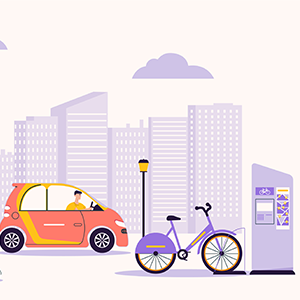

The P-factor - an underestimated instrument
Many companies have long recognized the importance of contemporary mobility management. Whereby "contemporary" means, above all, meeting the mobility needs of employees in a way that is both economically sensible and ecologically sound - and thus sustainable in every respect.
In fact, modern corporate mobility management has a wide range of potentials: Among other things, it can contribute to the goals of a company's ESG strategy (Enviromental, Social, Governance = environment, social responsibility, good corporate governance), increase employee satisfaction and contribute to a transformation of individual mobility. But before we talk about the benefits of corporate mobility concepts, let's first look at the diversity of their possibilities.
Professional mobility becomes measurable - with diversity instead of renunciation
A future-proof corporate mobility concept combines the demands of the company and its employees. The "one size fits all" principle - until now primarily: "one car" - is a thing of the past. The life situations and mobility behavior of the workforce are too different, and the modern working world with hybrid work and flexible time models is too heterogeneous. A good concept therefore requires a holistic view and analysis.
Added to this are the justified concerns of the environment and society. A well-designed corporate mobility management system can reduce CO2 emissions in commuter, business, and educational traffic as well as in the everyday mobility of employees, just as it can reduce car traffic in general. The more precisely certain KPIs and their targets are defined, the more successful this becomes. An example of this is provided by Olga Nevska, Head of Fleet at Deutsche Telekom, who explains, "I am measured by the actual CO2 emissions of our fleet, not by the manufacturers' specifications and the WLTP standard." [1]
In principle, corporate mobility management should influence the mobility behavior of employees in the desired sense - and without imposing restrictions on them. Ideally, there are even concrete cost, time, comfort, health, and other benefits for the workforce.
New thinking and sometimes offbeat ideas: Measures of modern mobility concepts
Today, companies have a large bundle of possible measures at their disposal, which can be individually put together for each company, its business model, its geographical location and other framework conditions. Standard measures include the promotion of cycling, discounts on public transport, the conversion of vehicle fleets to sustainable drive types, sharing models, and the digital coordination and control of traffic flows. As a collection of practical examples from the Mittelstandsinitiative Energiewende und Klimaschutz (MIE) [2] illustrates, this can be implemented in a wide variety of ways, for example by...
- the introduction of a job ticket and a transferable public transport ticket for business trips
- the provision of company bicycles
- the offer of bicycle leasing with employer subsidy
- Optimization and electrification of the vehicle pool
- Establishment of charging infrastructure for electric cars and pedelecs
- Participation in car sharing to cover peak load requirements
- the introduction of an ecological business travel regulation
- Establishment of a platform for carpooling
- Cooperation with eco-taxi companies
- the implementation of driver safety and fuel-saving training courses
- Promoting cycling by providing changing rooms and improved parking facilities
- Expansion of the network of footpaths
- intensifying employee communication on sustainable mobility
- Improving travel information on the Internet for visitors and customers.
True out-of-the-box ideas are also becoming increasingly common. For example, there are companies that give employees who travel by train on vacation an extra day of vacation. The food brand Veganz has even provided employees with a campervan for environmentally friendly vacations. The search engine Ecosia offers a repair service for employees' bicycles twice a year. Others promote challenges by tracking and rewarding bicycle kilometers ridden. [3] Another company rewards sustainable employee mobility behavior through annual one-time payments.
While bonuses and other benefits serve as a control instrument here, more and more companies are relying on employees' personal responsibility and defining mobility budgets. Here, the employer grants employees a certain credit that they can use individually for the means of transportation of their choice.
Cars remain the backbone of mobility - parking management comes into focus
No matter how much the modern spectrum of ideas for corporate mobility revolves around bicycles, public transportation and other "car-free" options - the fact is that professional mobility will continue to be represented by cars in the future. Be it employees' own vehicles, company cars or sharing vehicles. And since these still numerous cars have to be parked somewhere, parking management is an integral part of any holistic corporate mobility concept.
Interestingly, parking management has hardly been considered in this context so far. Even in the list of the MIE, parking as a component of operational mobility management appears only once. And this rather restrictively: The Darmstadt Rhine-Main-Neckar Chamber of Industry and Commerce no longer provides parking spaces in the underground garage free of charge. Instead, the parking ticket, which is now subject to a charge, includes a job ticket for local public transportation in addition to access authorization for the underground parking garage. The Chamber of Industry and Commerce draws a positive conclusion from this and states: "Without having to forego the offer of parking spaces for motorized individual transport, the use of public transport could thus be strengthened." [4]
As good as this approach sounds - it is not possible to measure the shift to public transport. But any sustainable mobility concept requires transparency. Without concrete knowledge of actual mobility behavior, it is almost impossible to manage it in a targeted manner.
This is precisely where digital parking management based on the parkoneer principle can provide support: In advance, a company determines who is allowed to park their car in the company parking lot and at what times. Each parking transaction is recorded by means of license plate recognition upon entry and exit. This enables valuable conclusions to be drawn about parking space utilization, vehicle use in the course of shared mobility, and other parameters for optimizing a company mobility concept, as Works Council member Stefan Hirsch describes in an interview. This is all the more true when access control is linked to an access solution, as made possible by parkoneer's cooperation with dormakaba.
Parking management strengthens corporate mobility strategy
These valid data on the parking and mobility behavior of the workforce not only create transparency, they also offer interesting starting points for incentives in terms of the mobility strategy.
Companies that work with mobility budgets could, for example, set a certain number of points for each "parking day. Those who park less can use their points in other ways, such as leasing a company bicycle. Equally conceivable are bonuses for employees who do without a car and parking space more often - or even, conversely, leave their vehicle on company premises for longer periods of time. Companies that want to promote the switch to electromobility could use digital parking management to reserve parking spaces with charging points for e-cars in a targeted manner.
The many possibilities of digital parking management within the corporate mobility concept result in extensive benefits:
- Digital parking management has numerous features that can improve a company's environmental footprint. Read more about this in the article "Parking and sustainability".
- Secure parking for all employees increases the attractiveness of the company or its location for skilled workers.
- Less traffic looking for parking relieves the burden on residents and the traffic infrastructure.
- A parking space guaranteed during individual working hours increases employee satisfaction. Read more here.
- Digital processes within mobility management help reduce a company's location costs.
- A study on the relationship between commuting and productivity found that employees with stress-free commutes have lower absenteeism, work more efficiently and stay at work an average of one hour longer per day. And what is more reassuring on the way to work than the certainty of finding a guaranteed free parking space?
- A digital parking management system increases the utilization of existing spaces so significantly that, as a rule, no new parking spaces need to be built.
- With the help of parking permits and access controls, a company can prove to the authorities that it provides enough parking spaces for employees. This is because, thanks to dynamic utilization, far more employees can park on the company premises than there are parking spaces available.
- Digital parking management gives urban and traffic planning new freedom, which benefits the quality of life in cities. Read more in the article "Sustainable traffic planning".
Conclusion
Companies that incorporate digital parking management into their operational mobility concept gain significant control options and achieve numerous positive effects. After all, parking is an inseparable part of the mobility of today and tomorrow.
